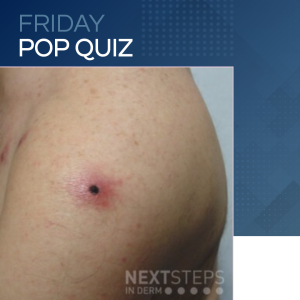
The correct answer is B. Group A beta-hemolytic streptococci.
Ecthyma is a deep or ulcerative type of pyoderma commonly seen on the lower extremities and buttocks and is caused most often by group A beta-hemolytic streptococci and Staphylococcus aureus. Ecthyma can present as small punched-out ulcers or a deep-spreading ulcerative process. The disorder begins in the same manner as impetigo, often following infected insect bites or minor trauma, but penetrates through the epidermis to produce a shallow ulcer.
The initial lesion is a vesiculopustule with an erythematous base and firmly adherent crust. Removal of the crust reveals a lesion deeper than that seen in impetigo, with an underlying saucer-shaped ulcer and raised margin. The lesions are painful and heal slowly over a few weeks, often with scar formation.
Ecthyma gangrenosum is a cutaneous finding that may be seen in patients with Pseudomonas aeruginosa bacteremia. Most of the affected individuals have an underlying immunodeficiency (either congenital or acquired) or a history of cancer chemotherapy. Neutropenia may be a risk factor for ecthyma gangrenosum.
References:
Korte AKM, Vos JM. Ecthyma Gangrenosum. N Engl J Med. 2017;377(23):e32. doi:10.1056/NEJMicm1702302
